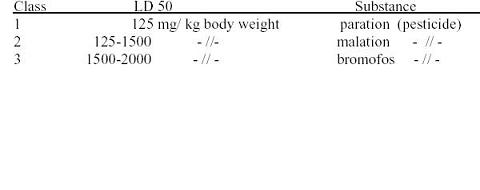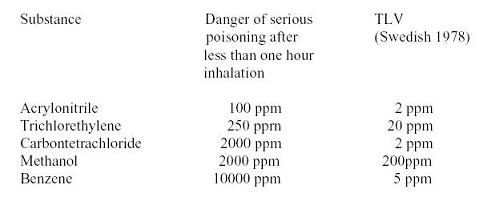
Poisoning and other risk with cargo contact onboard chemical tankers
Different chemicals affect the human body in many different ways. A general information and some practical advice are available in Appendix,7, of "Medical first aid guide for use in
accidents involving dangerous goods" published by IMO, WHO and ILO ref (36).
The definition of "poisonous" and classification of poisons is not uniform throughout the world. We can define a poison as a substance which is harmful to human beings (or environment). In the IMO Code ref (25) a substance is classified as a poison if there is a risk of death or serious bodily harm after oral intake, inhalation or skin contact.
The definition of "poisonous" and classification of poisons is not uniform throughout the world. We can define a poison as a substance which is harmful to human beings (or environment). In the IMO Code ref (25) a substance is classified as a poison if there is a risk of death or serious bodily harm after oral intake, inhalation or skin contact.
The "poisonousness" of a substance is usually expressed in terms of LD 50- values, Lethal Dose (sometimes LC
509 Lethal Concentration). These values are determined by tests with animals and give the dose, expressed in
mg/kg body weight, which kills 50 % of the animals in a test series. This figure gives a rough indication of the
degree of toxity of a substance. Various species of animals have different sensitivity, which gives some
problems in applying the results to human beings. Examples of LD 50 values (pesticides of three categories):

In industry the effect of long time exposure of low concentration to a substance is of prime concern. The
expression used is TLV (Threshold Limit Value), previously called MAC (Max Allowable Concentration). The
TLV-value expresses the concentration of a substance in air, in ppm (parts per 3 million) or mg/cm , which
must not be exceeded if a daily 8-hour exposure over a long period of time shall be harmless.
TLV-values are published by National Authorities and various organizations. The most recognized list of TLV-values is probably the one published by ACGH (American Conference of Governmental Hygienists ref (15). The ICS-Guide ref(1) also gives TLV-values. The gas concentration can be measured by means of a portable apparatus described in 3. 10 (Drager, Auer). The scale of reference for gas exposure on board is normally TLV -values. Human beings can, however, tolerate a significantly higher concentration in a short time exposure:

A person who is tired or ill is more sensitive than others and should not be asked to work with cargo handling. It is a good safety practice to use a breathing apparatus whenever the TLV-value in the atmosphere is exceeded
Related Info:
Chemical spill via Annex II overboard line
Risk with toxic substances carried by chemical tankers
Cargo hose disconnection - Personal Safety on Chemical Tankers
Poisoning hazards and countermeasures
Static electricity -How they generate & required safety precautions
Voyage planning and related considerations
Cargo sampling safety precautions
Preparation for cargo operation
Preparing a cargo tank atmosphere
Cargo unloading operation safety precautions
Liaison between ship and shore
International regulations for control of noxious liquid chemicals into sea
How to arrange disposal of tank cleaning waste ?
Retention of slops on chemical tankers
Preparations prior allowing personnel into cargo tanks / enclosed spaces
Cargo hose disconnection - Personal Safety on Chemical Tankers
Risk with noxious liquid cargo contact
Cargo handling equipments for handling noxious liquid substances in bulk
Cargo handling safe practices onboard modern chemical tankers
Product information required for various chemical cargo prior loading
Restriction on discharge of cargo residues into sea from chemical tankers
Static electricity -How they generate & required safety precautions
Main Info pages!
Home page ||| Chemical hazards ||| Cargo planning & Stowage ||| Cargo loading ||| Cargo documents ||| Safe stability ||| Cargo care ||| Preparation for unloading ||| Inert gas systems |||Gas freeing ||| Nitrogen handling ||| Chemical handling Safe practice |||Handling equipments ||| Cargo & Ballast pumps ||| Cargo tanks |||Tank cleaning |||Special cargoes |||Spills emergencies |||Fire protection

Chemicaltankerguide.com is merely an informational site about various aspects of chemical tankers and safety tips that may be particular value to those working in: Chemical Handling, Chemical Storage, Liquefied Chemical Suppliers, Chemical Shipping, Chemical Transportation, Chemical Terminals, Bulk Chemical Services and Chemical Processing. If you are interested in finding out more about chemical tanker guideline please visit IMO official website. For any comment please Contact us
Copyright © 2011 Chemical Tanker Guide.com All rights reserved.

TLV-values are published by National Authorities and various organizations. The most recognized list of TLV-values is probably the one published by ACGH (American Conference of Governmental Hygienists ref (15). The ICS-Guide ref(1) also gives TLV-values. The gas concentration can be measured by means of a portable apparatus described in 3. 10 (Drager, Auer). The scale of reference for gas exposure on board is normally TLV -values. Human beings can, however, tolerate a significantly higher concentration in a short time exposure:
A person who is tired or ill is more sensitive than others and should not be asked to work with cargo handling. It is a good safety practice to use a breathing apparatus whenever the TLV-value in the atmosphere is exceeded
Related Info:
Chemical spill via Annex II overboard line
Risk with toxic substances carried by chemical tankers
Cargo hose disconnection - Personal Safety on Chemical Tankers
Poisoning hazards and countermeasures
Static electricity -How they generate & required safety precautions
Voyage planning and related considerations
Cargo sampling safety precautions
Preparation for cargo operation
Preparing a cargo tank atmosphere
Cargo unloading operation safety precautions
Liaison between ship and shore
International regulations for control of noxious liquid chemicals into sea
How to arrange disposal of tank cleaning waste ?
Retention of slops on chemical tankers
Preparations prior allowing personnel into cargo tanks / enclosed spaces
Cargo hose disconnection - Personal Safety on Chemical Tankers
Risk with noxious liquid cargo contact
Cargo handling equipments for handling noxious liquid substances in bulk
Cargo handling safe practices onboard modern chemical tankers
Product information required for various chemical cargo prior loading
Restriction on discharge of cargo residues into sea from chemical tankers
Static electricity -How they generate & required safety precautions
Main Info pages!
Home page ||| Chemical hazards ||| Cargo planning & Stowage ||| Cargo loading ||| Cargo documents ||| Safe stability ||| Cargo care ||| Preparation for unloading ||| Inert gas systems |||Gas freeing ||| Nitrogen handling ||| Chemical handling Safe practice |||Handling equipments ||| Cargo & Ballast pumps ||| Cargo tanks |||Tank cleaning |||Special cargoes |||Spills emergencies |||Fire protection
Chemicaltankerguide.com is merely an informational site about various aspects of chemical tankers and safety tips that may be particular value to those working in: Chemical Handling, Chemical Storage, Liquefied Chemical Suppliers, Chemical Shipping, Chemical Transportation, Chemical Terminals, Bulk Chemical Services and Chemical Processing. If you are interested in finding out more about chemical tanker guideline please visit IMO official website. For any comment please Contact us
Copyright © 2011 Chemical Tanker Guide.com All rights reserved.
